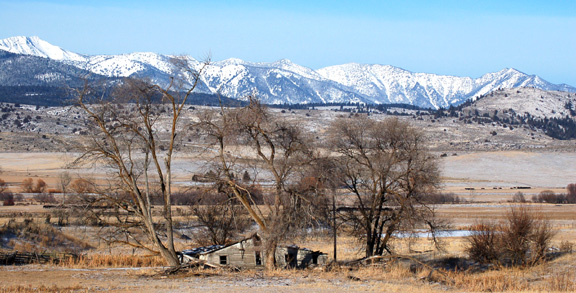In this Edition:
- Irish American History Slighted in the Schools
- Bad Week for Wolves
----- OSP & ODFW INVESTIGATING POSSIBLE WOLF DEATH IN UNION COUNTY
----- 9th Circuit Panel Upholds Congressional Rider Removing N. Rocky Mountain Wolves from ESA Protection
----- Wolves to the Slaughter
----- It’s perspective over perception for Carter Niemeyer
_____
Irish American History Slighted in the Schools
My Scottish and Irish ancestors on Dad's side of the family arrived in Boston, on their way to Wisconsin, in 1846. I don't suppose it was pure coincidence that the Irish potato famine had begun in September 1845. Before it ended, over one million Irish men and women were dead. It is worth noting that the fungus that caused the potato blight, which was in part responsible for the famine, had come to Ireland in ships sailing from North America, and resulted in more waves of Irish immigrants sailing for the United States in the same or similar ships.
In junior and senior high school, I learned that the potato blight was responsible for the famine, and it was not until some years later that I read about the "let 'em starve" attitudes of Englishmen who controlled the country at the time. One might think such a savage attitude was shed long ago by Christian and not so Christian hearts, but is was just a few weeks ago, in a conversation with a local proprietor about needed training for the poor and unemployed, that I heard those very words again: "let 'em starve."
On this Saint Patrick's Day, an Irish friend in La Grande sent me the following article about the sad lack of curriculum to teach about the history of the Irish in America, even though there "are 41 million Americans who claim 'Irish' as their primary ethnicity." By comparison, there around 50 million German-Americans, 50 million Hispanics, 5.3 Jewish-Americans, and 1.2 million people who self identify as British-Americans (although there are many, many millions more with a partial English heritage.) It is much more complex that this of course. For example, while I may be "mostly" Irish, I'm roughly 1/4 Scottish, and my Grandfather on my mother's side was Welsh, which while a part of Briton, is not the same as English. Anyway, apples mixing with oranges, no doubt.
Published on Thursday, March 15, 2012 by Common Dreams
The Real Irish American Story Not Taught in Schools
by Bill Bigelow
"Wear green on St. Patrick's Day or get pinched." That pretty much sums up the Irish American "curriculum" that I learned when I was in school. Yes, I recall a nod to the so-called Potato Famine, but it was mentioned only in passing.See Link above for rest of article.
. . . .
Nor do these texts raise any critical questions for students to consider. For example, it's important for students to learn that the crop failure in Ireland affected only the potato -- during the worst famine years, other food production was robust. Michael Pollan notes in The Botany of Desire, "Ireland's was surely the biggest experiment in monoculture ever attempted and surely the most convincing proof of its folly." But if only this one variety of potato, the Lumper, failed, and other crops thrived, why did people starve?
Thomas Gallagher points out in Paddy's Lament, that during the first winter of famine, 1846-47, as perhaps 400,000 Irish peasants starved, landlords exported 17 million pounds sterling worth of grain, cattle, pigs, flour, eggs, and poultry -- food that could have prevented those deaths. Throughout the famine, as Gallagher notes, there was an abundance of food produced in Ireland, yet the landlords exported it to markets abroad.
The school curriculum could and should ask students to reflect on the contradiction of starvation amidst plenty, on the ethics of food exports amidst famine. And it should ask why these patterns persist into our own time.
_____
Bad Week for Wolves
_
OSP & ODFW INVESTIGATING POSSIBLE WOLF DEATH IN UNION COUNTY
Reply
Michelle Dennehy michelle.n.dennehy@state.or.us
show details 5:39 PM (20 hours ago)
OSP news release, any questions about the investigation should go to OSP.
News Release from: Oregon State Police
OSP & ODFW INVESTIGATING POSSIBLE WOLF DEATH IN UNION COUNTY
Posted: March 16th, 2012 5:21 PM
Oregon State Police (OSP) Fish & Wildlife Division, with the assistance of Oregon Department of Fish & Wildlife (ODFW), is investigating the death of what is believed to be a wolf in northeast Oregon's Union County. The deceased animal's measurements and physical appearance match that of a wolf, but confirmation of the species is pending through DNA analysis.
On March 16, 2012 at approximately 8:30 a.m. OSP Fish & Wildlife Senior Trooper Kris Davis received a call regarding the discovery of a possible deceased wolf on private property about 6 miles north of Cove, Oregon. Davis and Sergeant Isaac Cyr responded and contacted the property owner and person who reported finding the deceased animal to Oregon Department of Fish & Wildlife this morning.
After taking possession of the 97-pound animal, OSP took it to a local veterinarian for x-rays. The initial examination didn't confirm a cause of death and the investigation will continue to determine if it was the result of a criminal act.
According to ODFW, a wolf in this area would not be part of one of the four known wolf packs in northeast Oregon. ODFW has received a handful of reports of wolf activity in this area over fall-winter 2011-12. The agency documented a single set of wolf tracks in the area twice in early October 2011 and again on January 31, 2012. Since January 31, ODFW has conducted track surveys and installed remote cameras in the area, but no additional sign of wolves has been found.
Wolves are protected by the state Endangered Species Act throughout Oregon. Except in the defense of human life or with a special permit, it is unlawful to kill a wolf. Doing so is a Class A misdemeanor punishable by up to one year in jail and a fine up to $6,250.
Anyone with information regarding this investigation is asked to contact Sergeant Isaac Cyr at (541) 523-5867 ext. 4170.
Questions regarding wolf management or activity should be directed to Michelle Dennehy, ODFW, at (503) 931-2748.
### www.oregon.gov/OSP ###
Contact Info: Sergeant Isaac Cyr
Oregon State Police - Baker City
Fish & Wildlife Division
Office: (541) 523-5867 ext. 4170
isaac.cyr@state.or.us
Wolf Management / Activity Contact Person:
Michelle Dennehy
Oregon Department of Fish & Wildlife
Phone: (503) 931-2748
__
9th Circuit Panel Upholds Congressional Rider Removing N. Rocky Mountain Wolves from ESA Protection
Center For Biological Diversity
Appeals Court Denies Challenge to Congressional Rider That Stripped Northern Rocky Mountain Wolves of Endangered Species Act Protection
For Immediate Release, March 14, 2012
Contact: Michael Robinson, (575) 313-7017
SAN FRANCISCO— The 9th Circuit Court of Appeals today denied a challenge brought by the Center for Biological Diversity and its partners to a congressional budget rider than stripped Endangered Species Act protections from wolves in the northern Rocky Mountains. A three-judge panel rejected the conservation organizations’ argument that the rider is unconstitutional because it violates the separation-of-powers doctrine.
“Congress set a terrible precedent by passing this backdoor rider that took away protection from wolves. Scientists, not politicians, need to decide which species need protection,” said Michael Robinson, a wolf expert at the Center. “That’s the law. And that’s what makes sense if we’re going to save animals and plants from extinction.”
The rider marked the first time Congress has removed a plant or animal from the endangered species list. The rider directed the U.S. Fish and Wildlife Service to reissue a rule removing federal protections from northern Rocky Mountain wolves, despite ongoing litigation over the lawfulness of that delisting rule.
Today’s ruling holds that the rider is constitutional because it amends the Endangered Species Act by exempting the delisting rule from all law. The panel rejected arguments by conservation groups that Congress violated the separation-of-powers doctrine because the rider blocked judicial review and ordered an outcome, in ongoing litigation, without clearly amending the Endangered Species Act, effectively negating the role of the judiciary.
“We will continue to fight the good fight on behalf of wolves across the country,” said Robinson. “These incredible animals deserve a shot at recovery beyond just the few pockets where they eke out a living today.”
After Endangered Species Act protections lifted in April 2010, the state of Idaho authorized hunting and trapping seasons with no limit on how many wolves can be killed and committed to maintain only 150 wolves out of an estimated population of at least 1,000. Montana set a hunting quota of 220 wolves with a goal of reducing the population by 25 percent. In Oregon, where the wolf population includes just two dozen or so wolves, state wildlife officials killed two wolves last year and planned to kill two more, but have been temporarily stopped by a state lawsuit filed by the Center and others.
“Wolves have been an integral part of North American landscapes for millions of years and are cherished, iconic animals that deserve a future in this country,” said Robinson. “If we want to keep wilderness alive in America, we need to keep our wolves.”
_
See Also:
The Ninth Circuit Court of Appeals Upholds Wolf Rider.
by KEN COLE on MARCH 14, 2012
The Ninth Circuit Court of Appeals has ruled against the many wolf advocacy groups who held that Congressman Mike Simpson’s and Senator Jon Tester’s budget rider, which delisted wolves in Idaho, Montana, and parts of Oregon, Washington, and Utah, was unconstitutional. The panel of judges upheld Judge Donald Mollloy’s ruling that the rider was constitutional.
Wolves will remain delisted unless their numbers drop below the minimum number of 15 breeding pairs and 150 wolves identified in Idaho’s or Montana’s wolf management plans. That may become increasingly difficult to prove if the rate of hunting and trapping success continues in Idaho. The Idaho Fish and Game already projects that by the end of the month there will be only 577 wolves left in Idaho. I don’t think this number accounts for unknown number of wolves killed illegally so it is likely high. . . . .
-
Wednesday, March 14, 2012
Federal Appeals Court Upholds Wolf Delisting
Conservationists Concerned for Wolves' Future
Contact: Jay Tutchton 720-301-3843
Other contact: Wendy Keefover | WildEarth Guardians | 303.573.4898 x 1162
Pasadena, CA – The Ninth Circuit Court of Appeals has upheld a legislative rider that eliminated Endangered Species Act protections for Northern Rocky Mountain wolves last April. Conservation organizations had challenged the constitutionality of the rider, which contravened a previous judicial order that reinstated protections for the Northern Rockies population. Wolves are now delisted in Montana, Wyoming, and parts of Oregon, Washington, and Utah.
__
Two excellent Articles on Wolves:
-
Wolves to the Slaughter
CHRISTOPHER KETCHAM MARCH 13, 2012
The reintroduction of the gray wolf to the Northern Rockies was an ecological success story—until big money, old superstitions, and politics got in the way.
In April 2001, a U.S. government wildlife trapper named Carter Niemeyer choppered into the mountains of central Idaho to slaughter a pack of wolves whose alpha female was famed for her whiteness. He hung from the open door of the craft with a semiautomatic shotgun, the helicopter racing over the treetops. Then, in a clearing, Niemeyer caught a glimpse of her platinum fur. Among wolf lovers in Idaho, she was called Alabaster, and she was considered a marvel—most wolves are brown or black or gray. People all over the world had praised Alabaster, had written about her, had longed to see her in the flesh. Livestock ranchers in central Idaho, whose sheep and cows graze in wolf country, felt otherwise. They claimed Alabaster and her pack—known as the Whitehawks—threatened the survival of their herds, which in turn threatened the rural economy of the high country. She had to be exterminated.
When Alabaster appeared in Niemeyer’s sights, a hundred feet below the helicopter, her ears recoiled from the noise and the rotor wash, but she was not afraid. She labored slowly along a ridge, looking, Niemeyer says, “like something out of a fairy tale.”
Then he shot her. . . . .
-
It’s perspective over perception for Carter Niemeyer
It’s perspective over perception for wolf researcher
March 13, 2012 by Scott Sandsberry
YAKIMA, Wash. —
Within six feet.
That’s how close Carter Niemeyer has been to wolves in the wild — conscious ones, that is, not counting the dozens he has trapped, darted and collared.
He has spent weeks alone in wolf country, sleeping in his one-man tent on ridgetops far from any gurgling creek, the better to hear the howling of the wolves and pinpoint their location.
Then he would go find them. Unarmed.
“I never carry guns when I’m working with wolves. Don’t even think of it,” Niemeyer says. “It just doesn’t even enter my thought processes to carry a gun when I’m out with wolves. They’re just not dangerous.
“But there’s a lot of people who tend to disagree with me on that.”
It’s that chasm between those willing to listen to Niemeyer’s viewpoint on wolves and those who would prefer to dismiss it — along with any and all wolves, for that matter . . . .












No comments:
Post a Comment